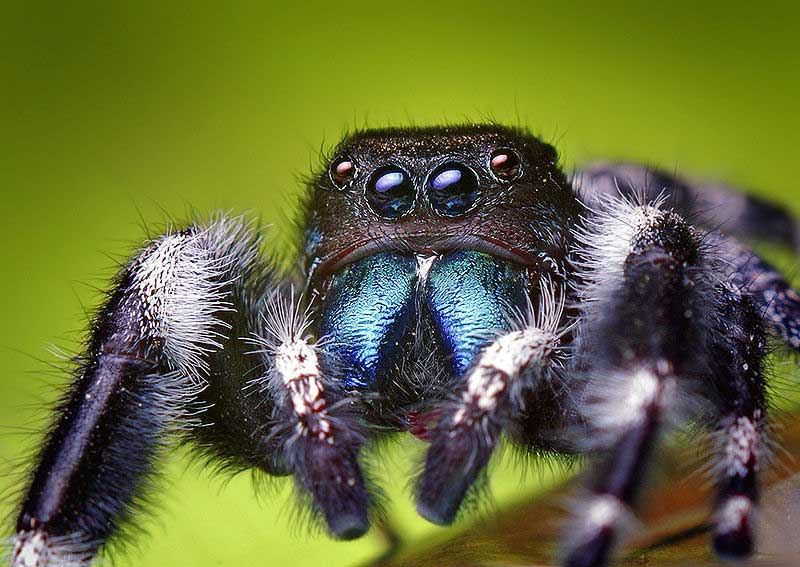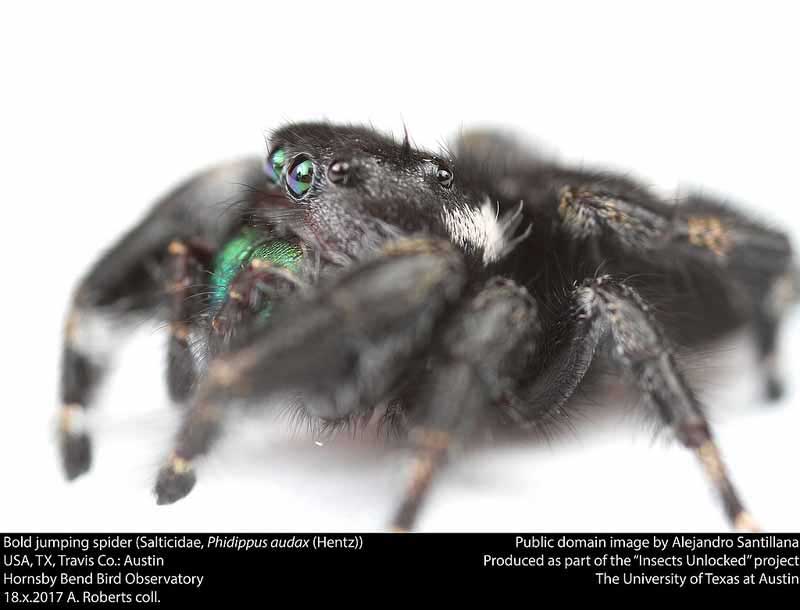
Phidippus audax (*)
Superregnum: Eukaryota
Cladus: Unikonta
Cladus: Opisthokonta
Cladus: Holozoa
Regnum: Animalia
Subregnum: Eumetazoa
Cladus: Bilateria
Cladus: Nephrozoa
Cladus: Protostomia
Cladus: Ecdysozoa
Cladus: Panarthropoda
Phylum: Arthropoda
Subphylum: Chelicerata
Classis: Arachnida
Ordo: Araneae
Subordo: Opisthothelae
Infraordo: Araneomorphae
Taxon: Neocribellatae
Series: Entelegynae
Sectio: Dionycha
Superfamilia: Salticoidea
Familia: Salticidae
Subfamilia: Salticinae
Clade: Marpissoida
Tribus: Dendryphantini
Subtribus: Dendryphantina
Genus: Phidippus
Species: Phidippus audax
Name
Phidippus audax (Hentz, 1845)
Synonyms
Attus audax Hentz, 1845

References
Hentz, N.M. 1845. Descriptions and figures of the araneides of the United States. Boston Journal of Natural History 5(2): 189–202, pl. 16–17. (Continued from Vol. IV, page 396.) BHL Reference page. [see p.199]
Phidippus audax is a common jumping spider of North America. It is commonly referred to as the bold jumping spider or bold jumper.[1] The spider belongs to the genus Phidippus, a group of jumping spiders easily identified both by their relatively large size and their iridescent chelicerae.
Like other jumping spiders, due to their large, forward-facing eyes, they have excellent stereoscopic vision. This aids them when stalking prey, and facilitates visual communication with potential mates during courting.
Description
Jumping spider of North America (Phidippus audax)
Phidippus audax varies widely in size and coloration.[2] Adult males range from 4–15 millimeters in body length, with an average of 8 mm. Adult females range from 4–18 millimeters in body length, with an average of 11 mm.[2] They are typically black with a pattern of spots and stripes on their abdomen and legs. Often these spots are orange-tinted in juveniles, turning white as the spider matures. However, in some parts of Florida it is common for adults to have yellow, orange, or red spots.[2] The chelicerae (mouthparts) are a bright, metallic green or blue.
Habitat
Like most jumping spiders, P. audax tends to prefer relatively open areas to hunt in, as they actively seek and stalk prey and do not build webs to catch food. They do use webbing, however only when nursing eggs or sheltering. They also use spider silk as a tether when jumping for prey or evading predators.
They are common in fields and grasslands, and are frequently seen on fences, exterior walls, and gardens as well. Many jumping spiders seem to prefer flat vertical surfaces, likely because it enables them to spot and chase down roaming insects with ease.
Distribution
This species is common in extreme southern Canada, throughout the United States and parts of northern Mexico, plus Cuba and Puerto Rico, and has been introduced to Hawaii and the Nicobar Islands.
Name
P. audax is the type species for the genus Phidippus. The species name is derived from the Latin word audax meaning "daring, audacious".
Bites
Like most spiders, P. audax rarely bites humans. While symptoms of a bite may vary, the most likely symptoms are pain, itching, swelling and redness with a duration of 1 to 2 days.[3]
In culture
As of 2021, this species is the State Spider of New Hampshire. The designation came after a campaign by a class in Hollis, New Hampshire, to designate a state spider.[4][5]
References
"Common Names of Arachnids (2003)" (PDF) (5th ed.). The American Arachnological Society. 2003. p. 10. Retrieved October 19, 2021.
Edwards, Glavis B. (2004). Revision of the jumping spiders of the genus Phidippus (Araneae, Salticidae). Florida Department of Agriculture and Consumer Services. pp. 72–76.
"Bold Jumper Spider". Penn State Department of Entomology. Retrieved March 6, 2020.
"Governor Chris Sununu Signs Spider Bill, 7 Other Bills Into Law". Governor Christopher T. Sununu. Retrieved June 16, 2021.
Ropeik, Annie (June 14, 2021). "Daring Or Bold? N.H.'s New State Spider Tends To Hide From Humans". www.nhpr.org. Retrieved June 16, 2021.
Further reading
Platnick, Norman I. (2009). The world spider catalog (version 9.5 ed.). American Museum of Natural History.
Retrieved from "http://en.wikipedia.org/"
All text is available under the terms of the GNU Free Documentation License

